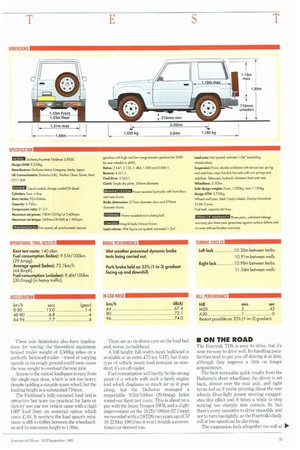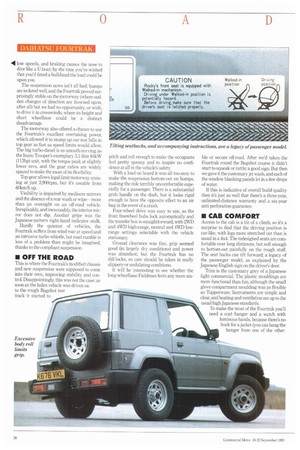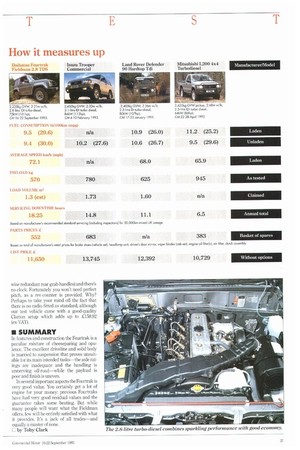These axle limitations also have implications for towing: the theoretical
Page 37

Page 38

Page 39

If you've noticed an error in this article please click here to report it so we can fix it.
maximum braked trailer weight of 3,500kg relies on a perfectly balanced trailer—travel at varying speeds or on rough ground could soon cause the nose weight to overload the rear axle.
Access to the cuboid loadspace is easy from the single rear door, which is not too heavy despite holding a sizeable spare wheel, but the loading height is a substantial 710mm, The Fieldman's fully-carpeted load bed is attractive but none too practical for farm or factory use; our test vehicle came with a rigid GRP load liner, an essential option which costs 4:101. It restricts the load space's minimum width to 0.88m between the wheelarches and its minimum height to 1.00m. There are no tie-down eyes on the load bed and, worse, no bulkhead.
A full-height, full-width mesh bulkhead is available at an extra .1275 (ex-VAT), but if any type of vehicle needs load restraint as standard, it's an off-roader.
Fuel consumption will hardly be the strong point of a vehicle with such a beefy engine and which displaces so much air as it goes along, but the Daihatsu managed a respectable 9.51it/100km (29.6mpg) laden round our Kent test route. This is about on a par with the Isuzu Trooper SWB, and a slight improvement on the 10.214/100km (27.7mpg) we recorded with a 2.8TDS two years ago (CM 16-22 May 1991) but it won't trouble a conventional car-derived van. The Fourtrak TDS is easy to drive, but it's none too easy to drive well. Its handling peculiarities tend to put you off driving it at first, although they improve a little on longer acquaintance.
The first noticeable quirk results from the Daihatsu's short wheelbase: the driver is set back, almost over the rear axle, and tight turns feel as if you're pivoting about the rear wheels. Over-light power steering exaggerates this effect and it takes a while to stop turning too sharply into corners. In fact there's every incentive to drive smoothly and not to turn too tightly, as the Fourtrak's body roll at low speed can be alarming.
The suspension feels altogether too soft at low speeds, and braking causes the nose to dive like a U-boat; by the time you've wished that you'd fitted a bulkhead the load could be upon you.
The suspension news isn't all bad: bumps are isolated well, and the Fourtrak proved surprisingly stable on the motorway (where sudden changes of direction are frowned upon, after all) but we had no opportunity, or wish, to drive it in crosswinds, where its height and short wheelbase could be a distinct disadvantage.
The motorway also offered a chance to use the Fourtrak's excellent overtaking power, which allowed it to stomp up our test hills in top gear as fast as speed limits would allow. The big turbo-diesel is as smooth-revving as the Isuzu Trooper's exemplary 3.1-litre 84kW (113hp) unit, with the torque peak at slightly lower revs, and the gear ratios are widely spaced to make the most of its flexibility.
Top gear allows legal-limit motorway cruising at just 2,900rpm, but it's useable from 60km/h up.
Visibility is impaired by mediocre mirrors and the absence of a rear wash or wipe—more than an oversight on an off-road vehicle. Inexplicably, and inexcusably, the interior mirror does not dip. Another gripe was the Japanese-pattern right-hand indicator stalk.
Hardly the quietest of vehicles, the Fourtrak suffers from wind roar at speed and an intrusive turbo whistle, but road rumble is less of a problem than might be imagined, thanks to the compliant suspension.
This is where the Fourtrak's modified chassis and new suspension were supposed to come into their own, improving stability and control. Disappointingly, this was not the case: as soon as the laden vehicle was driven on to the rough Bagshot test track it started to pitch and roll enough to make the occupants feel pretty queasy and to inspire no confidence at all in the vehicle's safety.
With a load on board it was all too easy to make the suspension bottom-out on bumps, making the ride terribly uncomfortable especially for a passenger. There is a substantial grab handle on the dash, but it looks rigid enough to have the opposite effect to an air bag in the event of a crash.
Four-wheel drive was easy to use, as the front freewheel hubs lock automatically and the transfer box is straightforward, with 2WI) and 4WD high-range, neutral and 4WID lowrange settings selectable with the vehicle stationary.
Ground clearance was fine, grip seemed good (in largely dry conditions) and power was abundant; but the Fourtrak has no diff-locks, so care should be taken in really slippery or undulating conditions.
It will be interesting to see whether the long-wheelbase Fieldman feels any more sta ble or secure off-road. After we'd taken the Fourtrak round the Bagshot course it didn't start to squeak or rattle; a good sign. But then we gave it the customary jet wash, and each of the window blanking panels let in a few drops of water.
If this is indicative of overall build quality then it's just as well that there's a three-year, unlimited-distance warranty and a six-year anti-perforation guarantee.
Access to the cab is a bit of a climb, so it's a surprise to find that the driving position is car-like, with legs more stretched out than is usual in a 4x4. The redesigned seats are comfortable over long distances, but soft enough to bottom-out painfully on the rough stuff. The seat backs can tilt forward; a legacy of the passenger model, as explained by the Japanese English sign on the driver's door.
Trim is the customary grey of a Japanese light commercial. The plastic mouldings are more functional than fun, although the small glove compartment moulding was as flexible as Tupperware. Instruments are simple and clear, and heating and ventilation are up to the usual high Japanese standards.
To make the most of the Fourtrak you'll need a coat hanger and a watch with luminous hands, because there's no hook for a jacket (you can hang the hanger from one of the other wise redundant rear grab handles) and there's no clock. Fortunately you won't need perfect pitch, as a rev-counter is provided. Why? Perhaps to take your mind off the fact that there is no radio fitted as standard, although our test vehicle came with a good-quality Clarion setup which adds up to £158.92 (ex-VAT).
In features and construction the Fourtrak is a peculiar mixture of cheeseparing and opulence. The excellent driveline and solid body is married to suspension that proves unsuitable for its main intended tasks-the axle ratings are inadequate and the handling is unnerving off-road-while the payload is poor and finish is uneven.
In several important aspects the Fourtrak is very good value. You certainly get a lot of engine for your money: previous Fourtraks have had very good residual values and the guarantee takes some beating. But while many people will want what the Fieldman offers, few will be entirely satisfied with what it provides. It's a jack of all trades-and equally a master of none.
E by Toby Clark


























































































